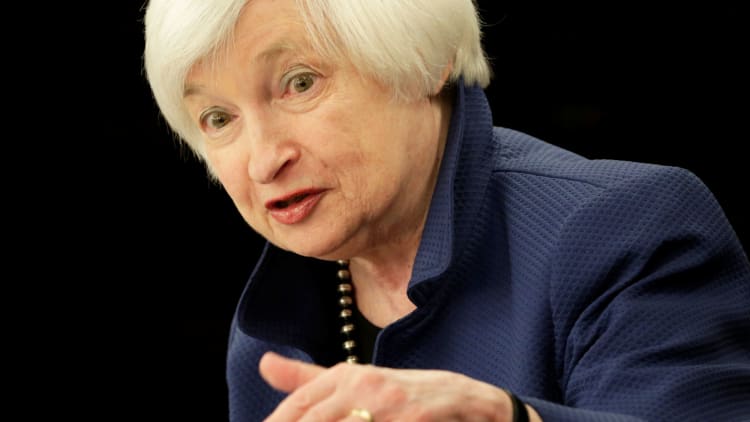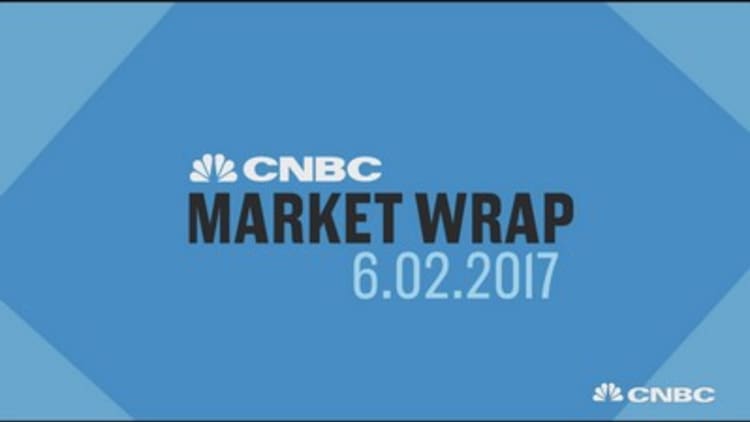
May's weak hiring and sluggish wage growth should not deter the Federal Reserve from raising interest rates in June, but it puts any further hikes this year in doubt.
There were 138,00 nonfarm payrolls added in May, and average hourly wages rose just 2.5 percent on an annual basis. The unemployment rate fell to 4.3 percent from 4.4 percent, viewed as a negative since the number of people participating in the workforce also declined.
Stock futures gave back gains after the report but reversed losses after opening lower and rose to new highs. Economists had expected job growth of 185,000, and some had raised their forecasts Thursday after ADP reported 253,000 private sector payrolls were added in May. Bond yields fell to their lows of the year, with the yield at 2.15 percent. Yields move lower when prices move higher.
"While the Fed still struggles to go in June, the one big takeaway from this report is that a September rate hike is largely off the table. September was always going to be a struggle because of its proximity to the debt ceiling debate," said Ian Lyngen, head of U.S. rates strategy at BMO Capital Markets.
There were also major revisions to March and April payrolls, with a total of 66,000 fewer jobs reported for those months, taking the three-month average to just 121,000.
"It is weaker than the rate we had in 2016, and certainly the first three months of this year. There is a notable shift there. The last three months average of 121,000 ... I think they'd have to go back a while to find a trailing three months that weak," said Ron Sanchez, chief investment officer at Fiduciary Trust.

"It begs the question, is this a reflection of tightness in the labor market, a natural decline? ... Is this a sign of a slower economy, or tightening labor market?" said Sanchez. He pointed to the steady declines in the unemployment rate, down 0.5 percentage point this year, and the drop to a 2007 low of 8.4 percent in the U6 rate, reflecting the longer-term unemployed. Sanchez said that would argue that the labor market is reflecting signs of tightness, meaning employers are having a hard time finding employees to hire.
But the lack of traction in wage growth is a concern."It still remains a mystery about why it's not transferring to wages. The Fed can view this as a maybe tightening labor market but one that is not so tight it creates inflation pressure," he said. That would argue for patience on the part of the Fed, he added.
"The markets haven't changed their view that the Fed is on a near-term path. It's still 90 percent for June in two weeks. The question is longer than that. There's seems questions about whether they move in September. It might be moved out to December, but it's too early," said Sanchez.
The Fed has forecast two more rate increases for this year, after its March hike, and it has also spelled out how it may begin to shrink its balance sheet late in the year.
"We have a debt ceiling showdown. We have uncertainty around
Employment and inflation are dual mandates of the Fed. While labor data have been solid, the central bank has watched core inflation slip away from its 2 percent target to 1.5 percent, as measured by the PCE deflator.
"This is enough of a gain for the Fed, given how their threshold is 100,000 or less, but it's going to be a tough one for the Fed and [rate-hiking path] going forward," said Swonk. "The average since the beginning of the year is 181,000. It still is strong enough for a third rate hike."
Swonk said the lack of wage growth is a puzzle. "They're not paying out as much, as they
"We're hearing a lot of complaints about the shortages. It's not being matched by wage acceleration," she said, adding that there has been
The most hiring in May was in the area of professional and business services, with 38,000 new jobs. Health care added 24,000, while mining added 7,000. Part-time positions rose by 133,000.
Watch: Stocks higher despite jobs miss



